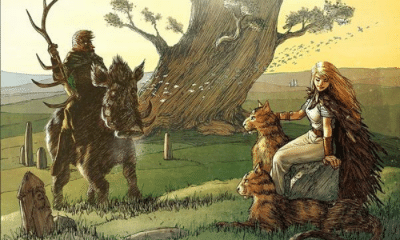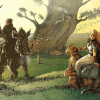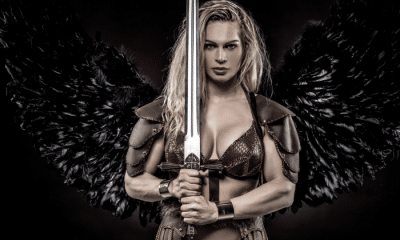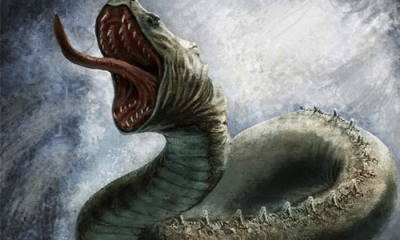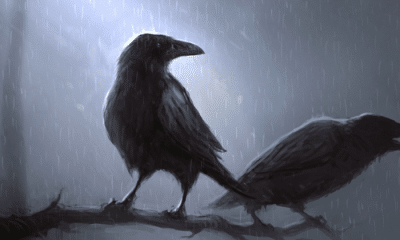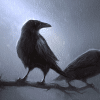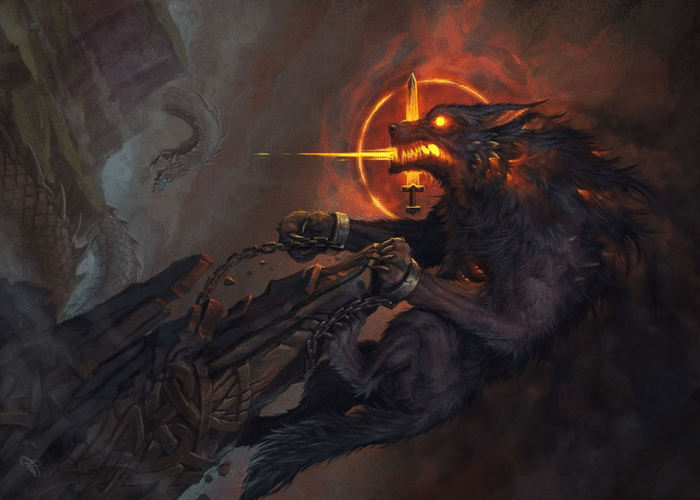
Norse
The Binding of Fenrir
The Binding of Fenrir
The monstrous wolf Fenrir was bound with an unbreakable cord before Ragnarök. But why he was bound and how it was accomplished is a dramatic story of its own.
Fenrir, Loki’s wolf son, was one of the Norse gods’ most powerful and ferocious enemies. From the time he was born, Odin knew that he was destined to play a terrible role in the events of Ragnarök.
Despite this, the gods allowed the wolf to live. According to the most famous story of the wolf’s life, they even fostered him at Asgard in an attempt to change fate.
As Fenrir grew more violent and enormous, however, the gods realized that he would need to be confined before he caused lasting damage. Binding the great wolf, however, would not be an easy prospect.
In the end, it took an invention of the dwarves, a series of tricks, and the sacrifice of a limb to confine Fenrir. Even then, the wolf would be free to get revenge on the gods when the world ended.
How and Why Fenrir Was Bound
Fenrir was one of the monstrous offspring of the trickster Loki and his jötunn mistress Angrboða.
The pair had three children. Fenrir was a wolf, Jörmungandr was an enormous sea serpent, and Hel was a woman whose body was partially rotted.
When the gods discovered Loki’s children, they knew the brood was destined to cause trouble. Odin had received his prophecies regarding Ragnarök, so he was aware that all of Loki’s children would play a role in the world’s demise.
The gods immediately resolved to banish Jörmungandr and Hel. The serpent was put into the depths of the sea while Hel, the most human of the group, was made the ruler of a grim Underworld in Niflheim.
The Aesir had different plans for Fenrir, however. Although he was destined to be dangerous, the gods thought that they could change fate and tame him.
For a time, therefore, Fenrir was raised among the Asgardians. They attempted to curb the young wolf’s more violent impulses and train him to see the gods as his friends rather than enemies.
Soon, however, it became obvious that controlling Fenrir would be more difficult than any of the gods had anticipated.
The wolf pup soon grew far beyond normal size for an adult wolf and kept getting larger still. He was soon so large and ill-tempered that only Tyr was brave enough to approach Fenrir and feed him.
The gods realized that they would not be able to keep Fenrir at Asgard. He was not yet fully grown but was still too dangerous and violent to be allowed to remain free.
They made a fetting called Leyding and tricked Fenrir into putting it on by telling him that they only wanted to test its strength. With a single kick the wolf broke the strongest chain the gods had ever made.
The second fetter they made, Dromi was twice as strong as the first. This time Fenrir strained for a moment, but in under a minute Dromi was broken as well.
The gods praised Fenrir for his strength, but the ease with which he broke their chains was actually quite frightening. They realized they would be unable to contain Fenrir themselves.
Odin sent a servant to the dwarves, hoping that their skill with metal would achieve what the gods could not. The dwarves sent back a lightweight ribbon.
This ribbon, Gleipnir, was made from six secret ingredients that only the most skilled dwarves could world with. Although it was light and thin, the gods could tell it was powerful as well.
The gods took Fenrir to a lake and marveled over the thin ribbon. They claimed that none of them had been able to break the strand, so they doubted even Fenrir could accomplish it.
Fenrir scoffed at the insignificant-looking thread. Tearing such a small thing, he said, would not earn him the acclaim that breaking strong chains would.
Fenrir sensed a trick, however, when the gods kept insisting that he try to break the ribbon. He cautiously agreed to have the ribbon tied around his legs, but only if he was given assurances that he would be safe.
As an assurance, he asked that one of the gods put their hand in his mouth. They would have to put themselves in danger to trick him.
Tyr, the only god who had been brave enough to work with Fenrir until this point, volunteered. He placed his right hand in the wolf’s jaws as the gods wound the thin thread around him.
When the ribbon was in place, Fenrir kicked his leg to break it. Instead, it only grew tighter. When he moved again, it pulled tighter still.
The wolf knew that he had been tricked and bit down on Tyr’s hand. The Aesir’s champion lost his sword hand as a sacrifice toward Fenrir’s binding.
The other gods laughed as the wolf’s bindings grew tighter with every movement. They secured Gleipnir to a strong rock and used another, even greater rock as an anchoring peg
Fenrir was securely bound, but he continued to snap and bite in the direction of the gods. One of the gods wedged a sword into Fenrir’s mouth to hold it open. If he tried to bite down he would be impaled.
The giant wolf would remain bound in that position until Ragnarök. Before the battle he would break free and join his father and siblings in their assault against the Aesir and the world of men.
In that battle, the great wolf would kill Odin and all the warriors of Valhalla. Using his boot, Odin’s son Víðarr would wedge the wolf’s mouth open once again and drive a sword into his throat.
In the Prose Edda, the question is posed as to why the gods did not kill Fenrir outright if they knew he would one day kill Odin. The narrator claimed that the gods were so respectful of the right of sanctuary that they could not defile the sacred ground of Asgard with the wolf’s blood once they had welcomed him.
My Modern Interpretation
Fenrir is one of many wolves that appear as enemies of the gods in Norse mythology.
Sköll and Hati, for example, were the brother and sister wolves that chase the sun and moon through the sky. They too would appear at Ragnarök when they would finally succeed in catching and devouring their quarry.
These two wolves were also Fenrir’s sons. Hati was called “the son of the famous wolf,” an epithet often used for Fenrir.
Garmr was the wolf who guarded Hel’s realm. In the final battle, he and Tyr would fight and destroy one another.
Some historians believe that Fenrir was once an even more menacing figure than he was in Prose Edda. All these wolves, they say, were once identified as Fenrir.
They believe that Snorri Sturluson, the writer of the Prose Edda, created at least three distinct wolves to take over roles once held by Fenrir. In older stories, the great wolf would have eating the sun and moon and killed Tyr before he faced Odin.
This explanation seems logical. Tyr would have likely wanted to face Fenrir after losing his hand and the origins given for Sköll and Hati, as children of a dangerous giantess, are similar to Fenrir’s own.
It seems likely that other parts of the story were similarly invented by Sturluson.
The explanation for why Fenrir was allowed to live, for example, is added within the story’s framing device. This makes it stand out as a later edition to rationalize a major plot hole in the story.
Most likely, the entire story of Fenrir’s early life among the gods was a later addition.
The wolf is also obsessed with the fame he would earn through his strength. “Fame wolf,” was a well-known poetic name for Fenrir, so it is possible that Sturluson included this with the name in mind.
Fenrir’s story fits into a common theme in Norse mythology, that of the bound monster. While many cultures had chained or imprisoned creatures, Norse mythology features the motif more often than any other.
In addition to Fenrir, Loki himself was bound until Ragnarök.
While Jörmungandr and Hel were not chained, they were each bound to a place. Jörmungandr could not leave the sea and Hel was confined to Niflheim until Ragnarök began.
Nidhogg was similarly confined beneath Yggdrasil’s root on Niflheim. The fire giants of Midgard would only leave their world, as well, when Ragnarök began.
It seems likely that Fenrir was one of these bound monsters but that the story of his binding was not as dramatic as it appeared in the Prose Edda. Details such as his relationship to Tyr and desire for fame were added later to expand on the story and make Fenrir a more complex character.
In Summary
In Norse mythology, Fenrir was one of Loki and Angrboða’s monstrous children. He and his siblings, Jörmungandr and Hel, were fated to be the gods’ most terrible enemies.
In the Prose Edda, however, the story is told of how the Aesir tried to change this fate. They raised Fenrir in Asgard in an attempt to tame him and prevent him from becoming their foe.
The wolf soon grew too large and violent to handle, however. The gods decided to bind him to keep him from destroying Asgard.
They tried two strong chains, but neither would hold Fenrir. They then sent to the dwarves who created a thin ribbon of a secret, unbreakable alloy.
Fenrir sensed a trap when the gods asked him to break this thin cord instead of the large chains he had won acclaim for. As an assurance, Tyr placed his right hand in the wolf’s mount as they wrapped the magical ribbon around him.
Fenrir could not break the cord so he bit down, taking Tyr’s hand. The task was done, though, and Fenrir would remain tightly bound until Ragnarök.
When that day came he and the other bound monsters of his family would break free to attack the gods. Fenrir himself would kill Odin and all the warriors of Valhalla before losing his own life to Víðarr.
Many wolves would be involved in Ragnarök according to the Prose Edda, but according to some historians the different names were inventions for this work. Originally, it was Fenrir who would be responsible for the destruction attributed to at least four separate beasts.
In fact, some historians believe that the Prose Edda’sentire depiction of Fenrir’s binding was a later edition. Many details were added to give personality and drama to one of many stories of the bound monsters who would emerge at the end of the world.


